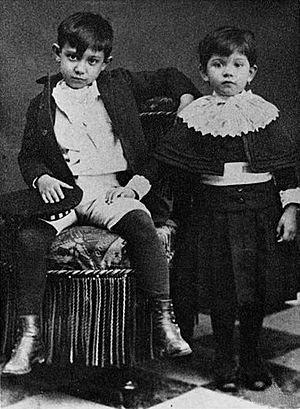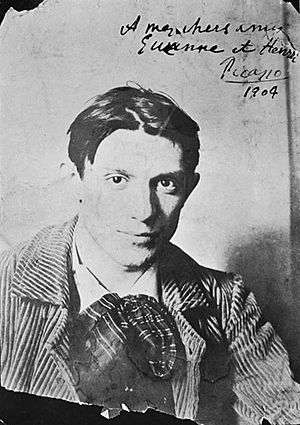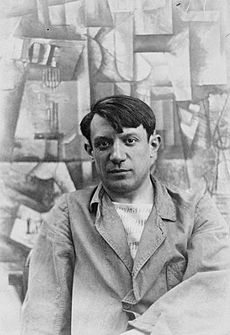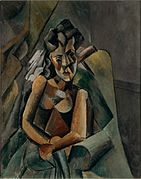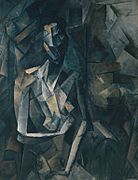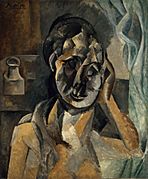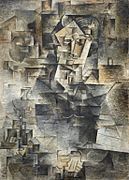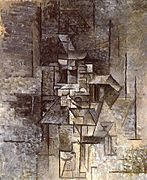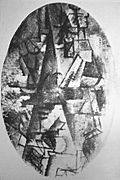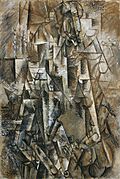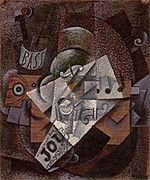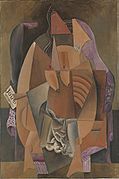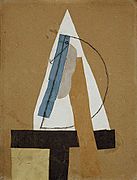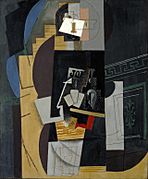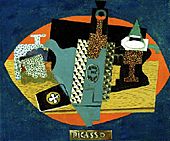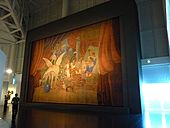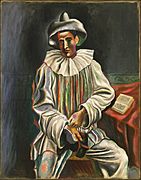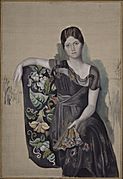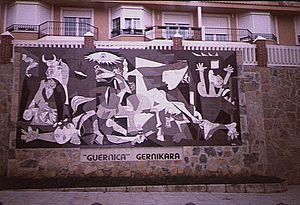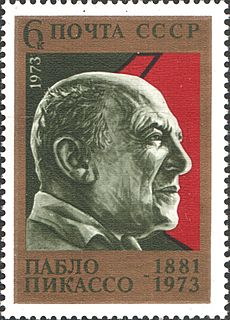Pablo Picasso facts for kids
Quick facts for kids
Pablo Picasso
|
|
|---|---|
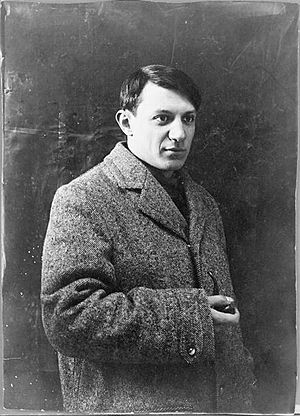
Picasso in 1908
|
|
| Born |
Pablo Diego José Francisco de Paula Juan Nepomuceno María de los Remedios Cipriano de la Santísima Trinidad Ruiz y Picasso
25 October 1881 |
| Died | 8 April 1973 (aged 91) Mougins, France
|
| Resting place | Château of Vauvenargues |
| Education | |
| Known for | Painting, drawing, sculpture, printmaking, ceramics, stage design, writing |
|
Notable work
|
|
| Movement | Cubism, Surrealism |
| Spouse(s) |
Olga Khokhlova
(m. 1918; died 1955)Jacqueline Roque
(m. 1961) |
| Partner(s) |
|
| Patron(s) | Sergei Shchukin |
| Signature | |
 |
|
Pablo Ruiz Picasso (25 October 1881 – 8 April 1973) was a Spanish painter, sculptor, printmaker, ceramicist and theatre designer. He was one of the most influential artists of the 20th century and is known for co-founding the Cubist movement.
Contents
Early life
Picasso was born at 23:15 on 25 October 1881, in the city of Málaga, Andalusia, in southern Spain. He was the first child of Don José Ruiz y Blasco (1838–1913) and María Picasso y López. Picasso's family was of middle-class background. His father was a painter who specialized in naturalistic depictions of birds and other game. For most of his life, Ruiz was a professor of art at the School of Crafts and a curator of a local museum. Ruiz's ancestors were minor aristocrats.
Picasso showed a passion and a skill for drawing from an early age. From the age of seven, Picasso received formal artistic training from his father in figure drawing and oil painting. Ruiz was a traditional academic artist and instructor, who believed that proper training required disciplined copying of the masters, and drawing the human body from plaster casts and live models.
The family moved to A Coruña in 1891, where his father became a professor at the School of Fine Arts. They stayed almost four years. On one occasion, the father found his son painting over his unfinished sketch of a pigeon. Ruiz felt that the thirteen-year-old Picasso had surpassed him.
In 1895, Picasso was traumatized when his seven-year-old sister, Conchita, died of diphtheria. After her death, the family moved to Barcelona, where Ruiz took a position at its School of Fine Arts.
Education
Ruiz persuaded the officials at the academy to allow his son to take an entrance exam for the advanced class. This process often took students a month, but Picasso completed it in a week, and the jury admitted him, at just 13. As a student, Picasso lacked discipline but made friendships that would affect him in later life. His father rented a small room for him close to home so he could work alone, yet he checked up on him numerous times a day, judging his drawings. The two argued frequently.
Picasso's father and uncle decided to send the young artist to Madrid's Real Academia de Bellas Artes de San Fernando, the country's best art school. At age 16, Picasso left home. He stopped attending classes soon after enrollment, because he did not like formal training. Instead, he spent time in the Prado, studying paintings by Diego Velázquez, Francisco Goya, and Francisco Zurbarán. Picasso especially admired the works of El Greco; elements such as his elongated limbs, arresting colours, and mystical visages are echoed in Picasso's later work.
Career
Picasso's work is often categorized into periods. The most commonly accepted periods in his work are the Blue Period (1901–1904), the Rose Period (1904–1906), the African-influenced Period (1907–1909), Analytic Cubism (1909–1912), and Synthetic Cubism (1912–1919). Much of Picasso's work of the late 1910s and early 1920s is in a neoclassical style, and his work in the mid-1920s often has characteristics of Surrealism. His later work often combines elements of his earlier styles.
Blue Period: 1901–1904
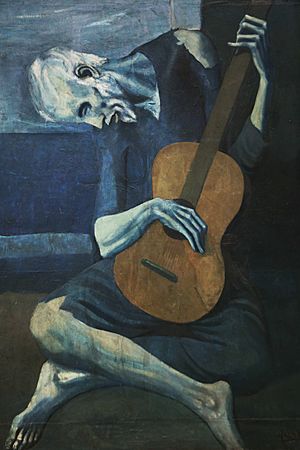
Picasso's Blue Period (1901–1904) began either in Spain in early 1901 or in Paris in the second half of the year. It called so as he mostly used shades of blue and blue-green for his paintings.
Rose Period: 1904–1906
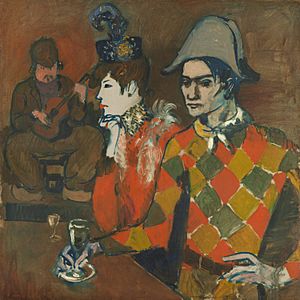
The Rose Period (1904–1906) is characterised by utilising orange and pink colours and featuring many circus people, acrobats and harlequins.
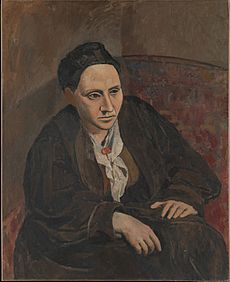
By 1905, Picasso became a favourite of American art collectors Leo and Gertrude Stein. Their older brother Michael Stein and his wife Sarah also became collectors of his work.
African art and primitivism: 1907–1909
Picasso's African-influenced Period (1907–1909) begins with his painting Les Demoiselles d'Avignon. When he displayed the painting to acquaintances in his studio later that year, the nearly universal reaction was shock and revulsion; Matisse angrily dismissed the work as a hoax. Picasso did not exhibit Les Demoiselles publicly until 1916.
Formal ideas developed during this period lead directly into the Cubist period that follows.
Analytic cubism: 1909–1912
Analytic cubism (1909–1912) is a style of painting Picasso developed with Georges Braque using monochrome brownish and neutral colours. Both artists took apart objects and "analyzed" them in terms of their shapes. Picasso and Braque's paintings at this time share many similarities.
Synthetic cubism: 1912–1919
Synthetic cubism (1912–1919) was a further development of the genre of cubism, in which cut paper fragments – often wallpaper or portions of newspaper pages – were pasted into compositions, marking the first use of collage in fine art.
Between 1915 and 1917, Picasso began a series of paintings depicting highly geometric and minimalist Cubist objects, consisting of either a pipe, a guitar or a glass, with an occasional element of collage.
-
1909–10, Figure dans un Fauteuil (Seated Nude, Femme nue assise), oil on canvas, 92.1 × 73 cm (36 x 28 in), Tate Modern, London. This painting from the collection of Wilhelm Uhde was confiscated by the French state and sold at the Hôtel Drouot in 1921
-
1910, Portrait of Daniel-Henry Kahnweiler, The Art Institute of Chicago. Picasso wrote of Kahnweiler "What would have become of us if Kahnweiler hadn't had a business sense?"
-
c.1911, Le Guitariste. Reproduced in Albert Gleizes and Jean Metzinger, Du "Cubisme", 1912
-
1911, Still Life with a Bottle of Rum, oil on canvas, 61.3 × 50.5 cm (24 x 19 in), Metropolitan Museum of Art, New York
-
1913, Femme assise dans un fauteuil (Eva), Woman in a Chemise in an Armchair, oil on canvas, 149.9 × 99.4 cm (59 x 39 in), Leonard A. Lauder Cubist Collection, Metropolitan Museum of Art
-
1913–14, L'Homme aux cartes (Card Player), oil on canvas, 108 × 89.5 cm (42 x 35 in), Museum of Modern Art, New York
-
1914–15, Nature morte au compotier (Still Life with Compote and Glass), oil on canvas, 63.5 × 78.7 cm (25 × 31 in), Columbus Museum of Art, Ohio
-
1916, L'anis del mono (Bottle of Anis del Mono), oil on canvas, 46 × 54.6 cm (18 x 21 in), Detroit Institute of Arts, Michigan
-
Parade, 1917, curtain designed for the ballet Parade. The work is the largest of Picasso's paintings. Centre Pompidou-Metz, Metz, France, May 2012
Neoclassicism and surrealism: 1919–1929
In February 1917, Picasso made his first trip to Italy. In the period Picasso produced work in a neoclassical style. Picasso's paintings and drawings from this period frequently recall the work of Raphael and Ingres.
-
Pablo Picasso, 1918, Pierrot, oil on canvas, 92.7 × 73 cm, Museum of Modern Art, New York
-
Pablo Picasso, 1918, Portrait d'Olga dans un fauteuil (Olga in an Armchair), Musée Picasso, Paris, France
In 1925, he took part in the first Surrealist exhibition in Paris. Between 1924 and 1926, Picasso preferred to paint abstract still lifes.
In 1928, he started a new period. He began to make sculptural works.
Before the Second World War
In 1936, Picasso got a job as director of the Prado-Museum in Madrid. During this time, the Spanish Civil War started. German bombs fall on Guernica in Spain on 26 April 1937. Picasso used this impact to paint one of his most famous paintings, Guernica. This painting was completed in about 2 months. It was first shown in the Spanish Pavilion in Paris in 1937.
During the Second World War
In 1938, Picasso's mother died. After the Second World War started on 1 September 1939, Picasso returned to Paris. In 1941, he wrote his first play "Le désir attrapé par la queue" (English: Desire Caught by the Tail). It was first shown in 1944. Also in 1944, Picasso joined the communist Party. Picasso spent almost the full war time in Paris.
Personal life
Picasso was married twice and had four children by three women:
- Paulo (4 February 1921 – 5 June 1975, Paul Joseph Picasso) – with Olga Khokhlova
- Maya (5 September 1935 – 20 December 2022, Maria de la Concepcion Picasso) – with Marie-Thérèse Walter
- Claude (born 15 May 1947, Claude Pierre Pablo Picasso) – with Françoise Gilot
- Paloma (born 19 April 1949, Anne Paloma Picasso) – with Françoise Gilot
Photographer and painter Dora Maar was a constant companion of Picasso. The two were closest in the late 1930s and early 1940s, and it was Maar who documented the painting of Guernica.
Death
Pablo Picasso died on 8 April 1973 in Mougins, France, from pulmonary edema and heart failure, while he and his wife Jacqueline entertained friends for dinner. He was buried at his Château of Vauvenargues near Aix-en-Provence.
Interesting facts about Pablo Picasso
- Although Picasso was Spanish, he spent most of his adult life in France.
- At birth, he was given a very long name, combining those of various saints and relatives. The record of his baptism stated that his full name was 'Pablo Diego José Francisco de Paula Juan Nepomuceno María de los Remedios Cipriano de la Santísima Trinidad Ruiz y Picasso'.
- According to his mother, his first words were "piz, piz", a shortening of lápiz, the Spanish word for "pencil".
- Henri Matisse was Picasso's lifelong friend and rival. The two met in 1905.
- In 1944, Picasso joined the French Communist Party.
- In 1950, received the Stalin Peace Prize from the Soviet government. In 1962, he received the Lenin Peace Prize.
- As a communist, Picasso opposed the intervention of the United Nations and the United States in the Korean War.
- On 9 January 1949, Picasso created Dove, a black and white lithograph. It was used to illustrate a poster at the 1949 World Peace Council and became an iconographic image of the period, known as "The dove of peace". Picasso's image was used around the world.
- Picasso made a few film appearances, always as himself, including a cameo in Jean Cocteau's Testament of Orpheus (1960).
- In 1955, he helped make the film Le Mystère Picasso (The Mystery of Picasso) directed by Henri-Georges Clouzot.
- In 1967, Picasso refused to be paid $100,000 for the Chicago Picasso, which is one of the most recognizable landmarks in downtown Chicago. He donated the money to the people of the city.
- Picasso also wrote poetry. Between 1935 and 1959 he wrote over 300 poems.
- As of 2015[update], Picasso remained the top-ranked artist (based on sales of his works at auctions) according to the Art Market Trends report.
- More of his paintings have been stolen than any other artist's; in 2012, the Art Loss Register had 1,147 of his works listed as stolen.
- Picasso is played by Antonio Banderas in the 2018 season of Genius which focuses on his life and art.
Museums
- The Museu Picasso in Barcelona. It features many of his early works, created while he was living in Spain, including many rarely seen works which reveal his firm grounding in classical techniques.
- The Museo Picasso Málaga opened in 2003 in his birthplace, Málaga, Spain.
- The Musée Picasso, Paris. Picasso's paintings left after his death form the core of this collection.
See also
 In Spanish: Pablo Picasso para niños
In Spanish: Pablo Picasso para niños


